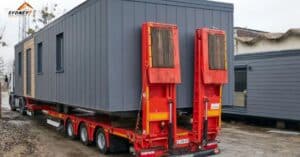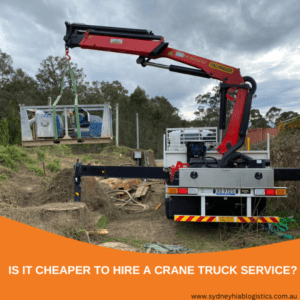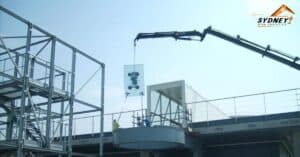Transporting oversized machinery is no small feat. It requires careful planning, specialised equipment, and a detailed approach to ensure safety throughout the process. One of the most reliable pieces of equipment for handling large, heavy machinery is the HIAB crane. With its robust lifting power and versatility, HIAB cranes have become a go-to choice for businesses and contractors needing to move oversized equipment.
If you’re looking to transport oversized machinery with a HIAB crane, this checklist will guide you through the process and help you ensure a safe and efficient operation.
1. Understand the Machinery’s Size and Weight
Before you even think about loading or transporting the machinery, it’s essential to know its exact size and weight. The dimensions of the equipment will affect how it’s loaded, transported, and unloaded.
- Measure the length, width, height, and weight of the machinery.
- Consider any additional parts or attachments that might affect its overall size or weight.
Having this information upfront will help in selecting the appropriate HIAB crane model and ensure you have the correct transportation vehicles.
2. Choose the Right HIAB Crane Model
HIAB cranes come in various models, each with different lifting capacities and reach. The weight and size of the machinery will dictate the crane you use. A lighter crane won’t be able to handle large loads, while a crane that is too heavy may be overkill and inefficient.
- Match the crane’s lifting capacity with the weight of the machinery.
- Assess the reach and working radius of the crane, ensuring it can safely lift and move the machinery to and from the transport vehicle.
Consult with the crane operator or a professional to confirm you’re choosing the best equipment for the job.
3. Inspect the HIAB Crane and Equipment
A proper inspection of the crane and all related equipment is a vital part of ensuring a safe lifting process. Here’s what to check:
- Hydraulic Systems: Ensure that the hydraulic system is functioning properly and has no leaks.
- Lifting Components: Inspect the boom, jib, winches, slings, and hooks for any signs of wear or damage.
- Load Indicators: Verify that the crane’s load indicators are calibrated and functioning.
- Safety Features: Ensure that all safety features, including emergency stops, anti-overload systems, and stabilisers, are in good working condition.
It’s important to perform both daily and pre-lift inspections to avoid any unexpected issues during the operation.
4. Ensure Proper Load Securing and Rigging
When transporting oversized machinery, secure it properly to avoid shifting during transit, which could cause accidents or damage. The rigging process is critical to the safety of the entire operation.
- Use heavy-duty slings, chains, or straps that are rated for the machinery’s weight.
- Ensure the load is evenly balanced when rigging to prevent tipping or tilting.
- Use load binders and lifting hooks to secure the load firmly.
Consider using certified riggers to ensure the load is secured correctly and safely before lifting.
5. Check Transport Route and Permits
Planning the transport route is crucial to avoid delays, accidents, or damage to the machinery. Oversized loads often require special permits, especially when traveling on public roads.
- Plan your route carefully, taking into account the size of the load and any obstacles like bridges, low-clearance overpasses, or narrow roads.
- Obtain necessary permits from local authorities if the load exceeds legal size or weight limits.
- Consider the potential impact of the machinery on local traffic and plan accordingly.
It may be necessary to coordinate with traffic authorities or road management agencies to ensure that the transport is smooth and compliant.
6. Prepare the Site for Loading and Unloading
The site where the machinery will be loaded and unloaded must be prepared for the operation. This preparation ensures that both the crane and the machinery are positioned safely and effectively.
- Clear the area of any obstructions, debris, or hazards that could interfere with the operation.
- Ensure the ground is level and stable. Soft or uneven ground can lead to instability during the lift.
- Position the crane in a way that allows for maximum reach and minimises the risk of tipping.
- Check for nearby power lines and avoid any area where the crane’s boom could come into contact with them.
A clean, organised, and well-prepared site reduces the risk of accidents and ensures the operation is as smooth as possible.
7. Communicate and Coordinate with the Team
Effective communication is vital when transporting oversized machinery. The crane operator, riggers, drivers, and any other crew members involved in the process must be on the same page at all times.
- Use two-way radios or other communication devices to stay in constant contact during the operation.
- Ensure that everyone involved knows their role and understands the safety procedures.
- Establish hand signals and other non-verbal cues for situations where verbal communication might not be clear.
Clear and consistent communication helps to prevent errors and ensures a smooth operation from start to finish.
8. Monitor the Lift in Real-Time
Once the machinery is being lifted, it’s important to closely monitor the operation. Even with all safety precautions in place, it’s essential to be vigilant throughout the process.
- Ensure that the crane is operating within its rated capacity and avoid sudden, jerky movements.
- Watch for any signs of instability in the load, and immediately stop the lift if anything seems amiss.
- Use spotters to help guide the load, ensuring that the crane is moving the machinery safely and accurately.
Having a spotter team ensures that the crane operator has someone to monitor blind spots and provide critical feedback during the lift.
9. Unload Safely and Secure the Machinery
Once the machinery has been successfully transported to its destination, the unloading process needs to be handled with the same level of care as the loading process.
- Use the same care in rigging the load for unloading.
- Ensure that the area is clear of any personnel or equipment before unloading begins.
- Once the machinery is safely unloaded, secure it in place and check that everything is intact.
Take time to inspect the equipment after unloading to ensure no damage occurred during transport.
10. Post-Operation Review
Once the job is completed, review the operation with your team to assess the entire process. This step helps identify any areas for improvement for future machinery transports.
- Discuss any challenges or complications that occurred.
- Make note of any maintenance needs for the crane or equipment.
- Update any transport or safety procedures based on the lessons learned.
A post-operation review ensures continuous improvement in safety standards and efficiency for future projects.
Conclusion
Transporting oversized machinery is a complex and demanding task, but with the right preparation, the right equipment (like a HIAB crane), and a clear, detailed checklist, the process can be completed safely and efficiently. By following these steps, you ensure that both your machinery and your team are protected, and that the transport goes off without a hitch. Prioritise safety, maintain clear communication, and always check your equipment to ensure a smooth, successful operation.
Ready to transport your machinery safely and efficiently? Contact us today to book your HIAB crane rental or learn more about how we can assist with your next project. Let Sydney Hiab Logistics handle the heavy lifting for you!




